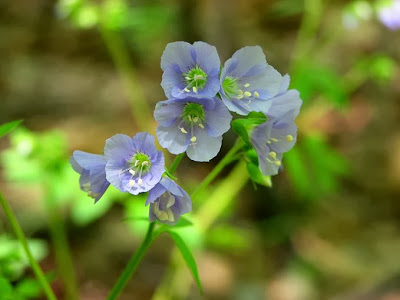Type of Flowers
Jacob's ladder:Polemonium, commonly called Jacob's ladder, is a genus of between 25 and 40 species of flowering plants in the family Polemoniaceae, native to cool temperate to arctic regions of the Northern Hemisphere. One species also occurs in the southern Andes in South America. Many of the species grow at high altitudes in mountains. Most of the uncertainty in the number of species relates to those in Eurasia, many of which have been synonymized with P. caeruleum in the past.
They are perennial plants (rarely annual plants) growing 10–120 cm tall with bright green leaves divided into lance-shaped leaflets, and produce blue (rarely white or pink) flowers in the spring and summer.
Polemonium species are used as food plants by the larvae of some Lepidoptera species including Coleophora polemoniella.
Jacob's Ladder seed in cell packs or flats, press into soil and lightly cover. Kept at 70° F., germination averages 25 days. Can direct sow Jacob's Ladder into prepared seed beds, in groups of 3-4 seeds spaced 12-18 inches apart.
Jacob's Ladder plants prefer afternoon or filtered shade, will tolerate deep shade. Best performance in rich, moist soil in moderate summer climates. Not adapted to the high heat and humidity of the deep South. Grow Jacob's Ladder in cottage gardens with Balloon Flowers, Columbines and foxgloves or in shaded borders with ferns, Astilbes and Hostas. Cut Jacob's Ladder back hard after flowering, this keeps plants neat, and encourages repeat bloom. Flowers attract butterflies.
These plants require minimal maintenance. After blooming, they can become leggy and need trimming. Jacob’s ladder plants will rebloom if the flower stems are cut back to the base. Sometimes, especially in older plants, the foliage can become brown and tattered looking. Trim out all unsightly foliage and new growth will begin almost immediately. Trimming Jacob’s ladder plants and the occasional foliar feeding is all that’s needed for the yearly care of Jacob’s ladder in the garden.



















